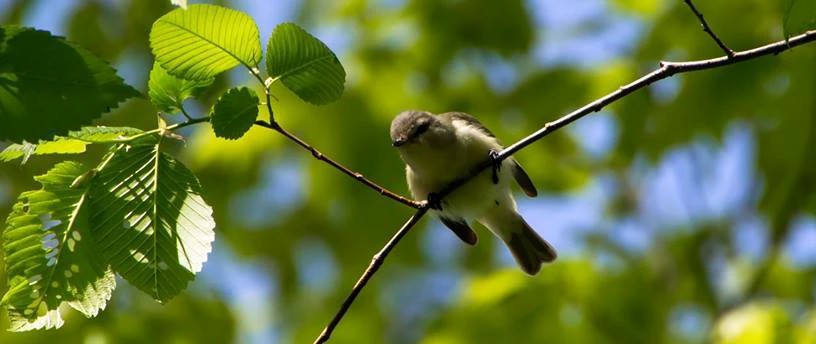Last updated: June 11, 2024
Article
Bird Community Monitoring at Effigy Mounds National Monument in Iowa, 2022

NPS
Why Do We Monitor Birds?
Birds are an important part of the world we live in. They eat pests, disperse seeds, pollinate plants, and feed us, and birdwatching is a multi-billion-dollar industry. Park interpretive programs often feature birds because of the enjoyment they provide. Birds are also great indicators of environmental change. They serve as the canary in the coal mine for an ecosystem—an early warning system for environmental change.
Habitat at Effigy Mounds National Monument supports a diverse array of bird species, including birds of regional concern. About 66% of bird species in the larger region are in decline, and some species are declining at alarming rates. Scientists in the Heartland Inventory and Monitoring Network measure changes in birds and their habitat to determine the health of bird communities and park ecosystems. During the breeding season, we survey for birds at Effigy Mounds National Monument and gather information about the structure and composition of the park plant communities that birds live in. We compare the trends of birds on the park to bird trends in the region. Together, these data help us determine how bird populations are faring and how birds respond to changes in their habitat. Knowing how birds are doing can help the park take effective steps to restore and maintain bird habitat.
Park Bird Community (2009–2022)
We started surveying for birds at Effigy Mounds National Monument in 2009. In 14 years of surveys, we have found 111 different bird species at the park. Ninety-six of these species have the potential to breed in the park. The number of bird species found during surveys and how they were distributed across the landscape was relatively unchanged over the years. The eight breeding species of concern (see table below) in the larger region around the park should be considered when managing habitat on the park.| Common Name | Scientific Name | Code |
|---|---|---|
| Bald Eagle | Haliaeetus leucocephalus | BAEA |
| Black-billed Cuckoo | Coccyzus erythropthalmus | BBCU |
| Blue-winged Warbler | Vermivora cyanoptera | BWWA |
| Brown Thrasher | Toxostoma rufum | BRTH |
| Cerulean Warbler | Setophaga cerulean | CERW |
| Dickcissel | Spiza americana | DICK |
| Red-headed Woodpecker | Melanerpes erythrocephalus | RHWO |
| Willow Flycatcher | Empidonax traillii | WIFL |

NPS
Bird Habitat
Effigy Mounds National Monument is in the Prairie Hardwood Transition Bird Conservation Region. Prairies once dominated the western and southern sections of this region, and beech-maple forest dominated the northern and eastern sections. Between these ecosystems was an oak savanna. Glaciation has resulted in numerous pothole-type wetlands, shallow lakes, and the coastal estuaries of the Great Lakes. There are many rivers in the region as well, including the Mississippi River. About 133 species of breeding birds are found in this bird conservation region, including dense populations of waterfowl. Habitat on the park lacks the extensive prairie component found in the region, but has a mix of deciduous trees, shrubs, permanent and seasonally flooded areas, and brushy openings that provide habitat for breeding birds.
Trends of Common Bird Species
Thirty-eight species were observed in sufficient numbers to calculate annual abundances and trends in the park. The American Redstart, American Robin, Baltimore Oriole, Eastern Wood Pewee, and Red-eyed Vireo were the most abundant and widespread species on the park. Regional bird trends from 2009 to 2019 were similar to those seen on the park with a few exceptions. American Robin, Brown-headed Cowbird, Common Grackle, and White-breasted Nuthatch were declining in the region but increasing in the park. Overall, the Effigy Mounds National Monument breeding bird community is faring better than birds in the region, based on our comparison of park and regional bird trends.

NPS
Species Highlight: White-breasted Nuthatch
White-breasted Nuthatches are year-round residents at Effigy Mounds National Monument. They prefer to make their homes in mature deciduous woods and woodland edges and are named for the behavior they use to store and hide food. This species burrows collected seeds and nuts in tree crevices and then covers up the food with little bits of bark, lichen, or moss to hide it. When they are hungry, they come back and “hatch” or hammer the food out of the crevices to eat. Most of the year they eat spiders and insects leaving the stored food for winter. White-breasted nuthatches are cavity nesters, making their nests in natural tree cavities or abandoned woodpecker holes. The habitat at Effigy Mounds National Monument suits them well. Our surveys showed that they were increasing on the park but declining in the region.
For More Information
Read the full report.Visit the Heartland Inventory and Monitoring Network website.
